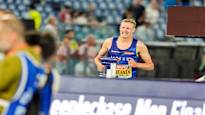It has not been very long since Finland’s only hopes of a medal in the prestigious games rested on the men’s javelin throw. Now we have returned to a familiar situation, writes Pekka Holopainen.
Pekka Holopainen sports reporter
ROME
On the way to the Stadio Olimpico and the awaited hype of Finland’s Euro Super Monday, I pondered the Urheilu expert Tuomas Rajan with, because the last time Finland achieved three medals in one day for adults in athletics.
It was worth thinking about because Wilma I break, Top Raitanen and Silja Kosonen it was thought to press the nets on the ball, so to speak.
I found such a day with a little searching: September 3, 1978, a hurdler Ismo Toukonendiscus thrower Mark That guy and hurdler Arto Bryggare each grabbed an EC medal in Prague’s cramped Rozicky Stadium.
The information acquisition was wasted this time. The more relevant question right now is: when was Finland last without a medal at the European Athletics Championships? It happened six years ago in Berlin, and a repeat of this very dark scenario is imminent.
Eight javelin races
In the years 2007–2016, eight prestigious competitions were held, where Finland’s only medal or medals came from the men’s javelin throw.
Now it’s as if nostalgically returning to the same situation; everything is by Oliver Helander to put it nicely, depending on the variable hit accuracy.
It’s pointless to get around it: Finland’s Super Monday turned out to be quite a stomach-churning, reflecting the expectations, even though Wilma Murtoak was considered more talented at the time Life Lampela fourth place, after all possible difficulties, almost tasted like a medal.
Murto came to Rome with his stiffest sticks, but without a realistic chance of getting far enough to need them. EC-Rome was the moving part of the season of three prestigious competitions after the Achilles injury in the spring winter, and the result was certainly disappointing, but mostly a logical consequence of several things.
No Olympic panic
Due to the long and mentally tough rehabilitation, scarce competition and very little jumping training, the standardized model of top jumping has not returned to the body’s memory. Paris is two months away and there is no reason for Olympic panic. The level of the sport this season will not rise to such a level that it would not be completely within Murro’s reach.
The reigning European champion Top Raitanen stomach fall in the obstacle final was total and the final time was about 10 seconds lower than in the preliminaries. The performance level is fluctuating, the recovery from the preliminary rounds was not successful at all.
The top three trotted a good European trot, under 8.15. Will Raitanen ever be able to do that during his career?
Toughest race in Eugene
On Monday, Silja Kosonen did not compete in nearly the toughest race of her season. He already did that in Eugene’s Diamond League, where the American ladies bombarded Kosose with a still very unreachable 76-78 meter landscape.
The current European underdog of the sport offered Kosose a medal with a very basic performance, which is a very rare situation for a Finnish – especially only 21-year-old – general athlete. No venipuncture was required.
Of course, it is also very rare that a Finnish track and field athlete of this age has been fifth in the World Championships and fourth in the European Championships, and may for some reason be very disappointed with the latter result.
